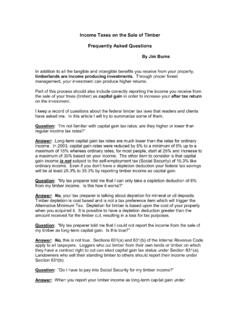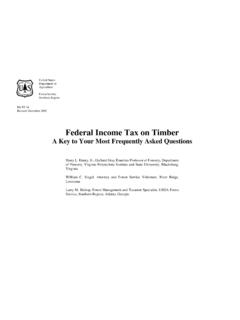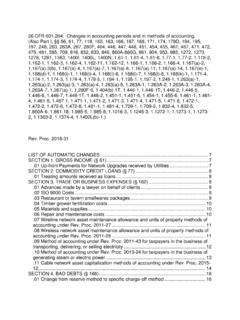Transcription of Timber Depletion Deduction - Metcalfe Forestry
1 Tax Tips For Landowners THE Timber Depletion Deduction By Jim Burns In my last article, I explained that Timber sale income should be reported as capital gain for income tax purposes. This insures that you will only be taxed at the lowest tax rates of 5% to 15%. If you mistakenly report this same sale as ordinary income, the government will be happy to collect your taxes based on much higher ordinary tax rates. You have a three-year period in which to amend this mistake, but don t expect to get a letter or call from the IRS informing you that you d paid more than was necessary! In any event, when you report your Timber income as a capital gain, you are entitled to take a Timber Depletion Deduction from the gross revenue to arrive at a net profit which is then taxed at the federal capital gains tax rates.
2 This Depletion Deduction is calculated in the same manner whether you report income under Section 631(a) or 631(b) of the IRS Code. The Depletion Deduction is a tax free return of how much the trees ( Timber ), growing on your land, cost at the date you acquired the property. But I didn t pay anything for trees or Timber when I received the property you say. Exactly! In this region of the country, a timberland purchase is normally for a lump-sum amount of money, say $150, This purchase price includes the acreage of soil involved plus the trees and any other components of value, such as a house or water frontage that comes with the land. So your $150, bought you a collection of assets, which individually contain fair market values as of the date of acquisition. In order to separate the value of each of these assets, an appraisal is required.
3 Using standard appraisal methods, let s say I find that this property has asset values of: Summer Cabin: $ 60, River Frontage: 10, Bare Land Value: 20, Timber : 110, Total $200, 2 Does this mean that the cost basis in the property is $200, Absolutely not! The cost basis in the property is what you paid for it - $150, The whole appraisal process revealed that the relative value of each asset to the whole is: Summer Cabin 30%: $ 45, River Frontage 5%: 7, Bare Land Value 10%: 15, Timber 55%: 82, Total $150, Continuing with this example, let s further say that the Timber growing on the land was good quality sugar maple and red oak with a total merchantable volume of 200 MBF (thousand board feet). The Timber Depletion Deduction for this property is then $82, divided by 200 MBF or $ per MBF.
4 This means that for every thousand board feet of sawtimber you sell you will get to deduct $ from the sale price to arrive at your taxable income. In this example, let s assume you sold some of the Timber for $ per MBF. If this were the case, you would have a loss of $ for every MBF sold. This loss would be deducted from any other capital gain you might have and/or have a recovery against ordinary income. The foregoing example illustrates an outright purchase of forestland, but there are a number of different ways that one can acquire property, each of which has a direct bearing on the cost basis. Remember, the higher the cost basis, the less income you will pay. Two other common ways that people acquire land are: 1.) You receive the timberland as a gift; or 2.) You inherit it from another person after their death.
5 In the first situation, Grandpa bought the property in 1938 for a total sum of $ In 1968 he then deeded the land to your father as a gift. Last year, your father does the same and gives the property to you. The sentiment is nice, but you now have a property worth $150, and a cost basis for Depletion of only $ This was not such a good deal if you are trying to minimize taxes. The better option would have been for your father to allow you to inherit the property upon his death which would give you the current market value of $150, for your new cost basis. Keep in mind that expenses, such as legal fees, surveying, cruising of Timber or other closing costs are also included in the cost basis when you purchase or otherwise acquire a property. Any subsequent capital expenses to the property such as tree planting, road building, etc.
6 , are also added to your cost basis. Jim Burns is a professional forester who owns and operates Burns Timber Tax Services and works in conjunction with Susan Metcalfe at Metcalfe Forestry LLC. For more information, call Susan at (989) 348-3596 with your questions.


